The Ministry of Defence has confirmed that the General Atomics MQ-9B is being evaluated as a potential carrier-based airborne early warning (AEW) platform for the Royal Navy.
In a recent parliamentary question, Ben Obese-Jecty, Conservative MP for Huntingdon, asked the Defence Secretary whether remotely piloted aircraft systems (RPAS) could be utilised for airborne early warning roles. Defence Minister Maria Eagle responded:
“The Ministry of Defence is actively assessing the potential of uncrewed remotely piloted aircraft systems (RPAS) to support airborne early warning (AEW) roles across the air environment. These assessments are part of broader efforts to modernise UK defence capabilities through the integration of autonomous systems. While current RPAS platforms are predominantly used for land and maritime surveillance tasks, future developments may enable their use in AEW missions.”
In a separate question, Obese-Jecty also inquired specifically about the feasibility of using the General Atomics MQ-9 for Royal Navy carrier-based operations. Minister Eagle revealed:
“Through the MQ-9 International Cooperation Support Partnership, of which the United Kingdom is a signatory, the Royal Navy (RN) has established that the General Atomics MQ-9 can be modified to operate from the Queen Elizabeth Class carriers. As such, the MQ-9 is being considered as a candidate for the RN’s requirement for Carrier Strike Airborne Early Warning following the planned withdrawal of the Crowsnest Airborne Early Warning system when it reaches the end of its service life.”
The current airborne early warning capability for the Royal Navy is provided by the Crowsnest system, integrated onto Merlin helicopters. However, the system is due to be retired, prompting the need for a next-generation solution. The potential use of the MQ-9B represents a shift towards uncrewed and remotely operated technology, reflecting a broader trend in modern military aviation.
The potential integration of the MQ-9B onto Queen Elizabeth Class carriers follows recent successful trials of the Mojave unmanned aircraft onboard HMS Prince of Wales. The Mojave trial, conducted off the East Coast of the USA, marked the largest uncrewed aircraft ever launched from a Royal Navy carrier, showcasing the feasibility of integrating large uncrewed aerial systems with existing naval aviation capabilities.
The success of the Mojave trials has likely influenced the consideration of the MQ-9B as a future carrier-based AEW asset.
The MQ-9B
The builders say that the MQ-9B SkyGuardian is the next generation of remotely piloted aircraft systems (RPAS), delivering persistent intelligence, surveillance, and reconnaissance (ISR) around the globe.
“SkyGuardian is designed to fly over the horizon via satellite for up to 40+ hours in all types of weather and safely integrate into civil airspace, enabling joint forces and civil authorities to deliver real-time situational awareness anywhere in the world—day or night. The aircraft is outfitted with the revolutionary Lynx Multi-mode Radar, an advanced electro-optical/infrared (EO/IR) sensor, automatic takeoff and landing, and features a longer wingspan than its predecessors at 79 ft (24m).”
The UK already operates a drone based on MQ-9B SkyGuardian, Protector RG Mk1.


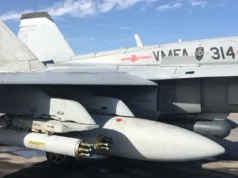

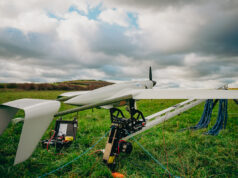
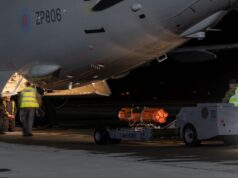
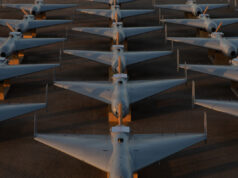
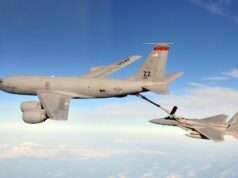
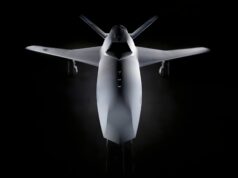

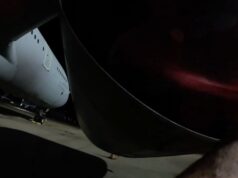
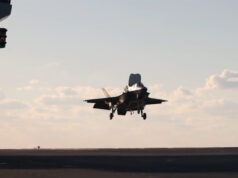

Their service ceiling is 40,000 feet, although I would assume that will be lower if they can be adapted for this role due to extra weight.
Still a lot better than Crowsnest.
Crowsnest seems to have been a quite expensive stopgap. Probably would have been cheaper to keep a few of the old Sea Kings going.
Agree it was a waste of money and retaining sea king AEW would have been a better use of public money and more importantly the precious MOD budget.
These drones might be a suitable option but we will need to bring both carriers in to make them CATOBAR capable for the drone surely? I know they can launch and recover from the carriers as is now but what happens when we had heavy electronics and power generation as well as SIGNIT and SIGNALs tech onboard the MQ series? I’m fairly certain that will add a fair few hundred lbs of extra weight.
Project Ark Royal should fit some sort of drone catapult to the carriers. However, I believe that’s pending a budget. The much anticipated SDR should give some guidance on that when it’s published.
I needed a giggle…..two jokes in one paragraph….publishing the SDSR is side splitting…..funding Ark Royal is next level…..
Retaining a handful of seakings would not have been a better use of funds. Another traning pipeline for aircrew and engineers. Another logistics tail. Many Seaking parts are long no longer supported or produced. Culdrose as a station is set up for Merlin,
not Seaking. Merlin is a vastly more capable helicopter.
Absolutely, I’ve suggested the same on numerous occasions and told the idea was ridiculous.
Here’s the thing, Carson Helicopters know every nut and bolt of the Sea King, they could have refurbished and upgraded a small number of air frames and carried out a small upgrade of the radar.
This would have been ‘vastly’ cheaper…
Crows nest has been a procurement disaster.
Not only a procurement disaster, but has also cut into the limited Merlin fleet.
Absolutely…
No it would not have been vastly cheaper.
While obviously not a direct comparison, Carson provided two rebuild Sea Kings to Argentina with two years maintenance and spares backup for $12.8 million.
So let’s say, we let Carson carry out a rebuild of 8 of our AEW7’s with maintenance and spares, and the Radar system was given minimum upgrades, what would we have??
I’m going to guess it could all have been comfortably done for less than $200 million and been at FOC very quickly.
We would have had 90% of Crowsnest capability years ago at less than half the £430 million ( and counting), a system that was supposed to be straight forward low risk solution, that’s barely reached FOC after years of trials and fixes!
Or have I got it wrong?? It wouldn’t be the first time to be fair…
To be fair that 200million saving would equal about 15-16 million a year spread over 15 years.. running a separate seaking squadron.. training pipelines for the ground crew as well as training for the pilots etc would have cost a lot.. I suspect that 200million would have disappeared.
The true waste was not procuring a decent system and trying to go cheap.
hindsight is always 20/20
I doubt keeping a few sea kings going would have saved any money… operating an aircraft type has an immense cost whether you have 2 planes, 10 or 50. You have to have the complete logistics tail in place, engineers and support staff, pilots etc plus the full training package (including simulators) etc. much of that cost is independent of platform numbers.
id hoped that the taranis project would have evolved to be a carrier based asset and force multiplayer. it disappeared suddenly but I hope it is resurrected. videos showed it’s possibilities we’ll have to wait and see what happens next.
With such a long flying endurance, even having to clear the deck for take off / land maybe doable. Cross wind and rough seas maybe still an issue.
With a wingspan of 79ft it will be an absolute bitch to handle even on the very wide flight decks of the QE’s. I suspect that if it does come to fruition it will look radically different to how it looks today.
Agreed, the mohave adaptions have shortened wingspan considerably as well as the wing shape. This will obviously have ramifications with regards endurance and load but whatever the result it’ll be a damned sight more effective than crowsnest
Absolutely, it has the airframe size to lift a capable radar, even with the shorter wing, if it was capable of 30,000ft for 12 or 16 hours it would be vastly more effective than Crowsnest.
so all they need do is change the wings and the airframe and fit high power radar and communications and fit launch and recovery systems to the carriers.
I just looked up the Lynx Multi Mode radar. While it claims maritime surveillance it only talks about ‘vessels’ and vehicles and dismounts in the land domain. It does not mention aircraft anywhere in the blurb. It is used by the RAF in the surveillance role but it doesn’t sound as if it is suitable for an AEW role where high speed flying targets are the main threat?
Nevertheless, it looks like a very capable piece of kit in a very small package.
Cheers CR
I also was under the impression that Lynx was not designed to track air targets such as jets and missiles, so it will be interesting to see if that is in fact a capability it possesses.
Still, if Mojave is going to be employed on the carriers, having an extra surface search capability would be useful.
The other thing I’d like to highlight is that the Lynx radar only has a range of around 80km. For the drone to actually detect a hostile warship, it would have to be well within the engagement of most Russian anti-air systems, and almost all of the Chinese systems.
Well then you’ll know there’s a Russian or Chinese warship nearby, won’t you? 😉
Role successfully filled!
There is more detailed specification data on the General Atomics website (search Lynx radar on goggle). If you click on the picture on the bottom of the Lynx radar page it will open a two page specification leaflet. The image looks like it has 3 triangles on it.
The maritime search radius is 300km. It is a very capable little radar, especially as it is less than 69kg in weight.
Cheers CR
Many thanks – the only range listed on the main website (that I could see) was the 80km range. It’s good to know that it will be outside of the reach of the majority of anti-air systems, though HHQ-9B could likely still pose a threat.
Lynx isn’t the radar fitted to the maritime MQ9s, and it certainly wouldn’t be used for AEW
It’s a tiny little radar, it fits inside the nose in front of the gimbal camera (which is why the MQ9B is so duck billed) and has a miniscule swept diameter.
However, GA-ASI has integrated the Leonardo SeaSpray 7500e, which can be fitted under the fuselage. That’s an updated version of the maritime search radar fitted to Merlin, and that’s what we would use for the general ASW/ASuW version. But it also has a secondary air surveillance mode, so better than nothing by a long way.
It isn’t the main option for AEW, though. That’s a concept that was displayed at CNE 2023 (and referenced in CGI since), which involves three pods slung under the wings and fuselage. Two under the wings would have sideways-looking AESA radar panels, while the one under the fuselage would contain the processing and cooling units.
That is more capable, with updated technology, than Merlin, but needs work on the power generation to be the long term AWACS option.
At least we’re going in the right direction.
Three or four drones autonomously orbiting the CSG.
If what they buy has real limitations they can upgrade it, and MQ9 is an MQ9, bolt whatever your want to it
You need to think this through. If you have 3 to 4 drones doing orbits around the carrier group. How long are they staying up for? Were they on station at the same time or time staggered? How many do you have for rolling through the patrols, 3, 4? Do you have enough spare aircraft to transit to the patrol area, which then lets the on patrol aircraft to return to the carrier? Is one of these the spare in case one needs maintenance, or scheduled maintenance?
These aircraft even with the STOL wing will need wing folding mechanisms. Otherwise their parked foot print is going to prohibit having other aircraft on deck, let alone in the hangar.
Apart from the mediocre radar these aircraft will only be able to carry. Trying to Marshall them around a carrier’s deck that has 2 squadrons of F35s and some helicopters, is going to be a nightmare.
CNE 25 starts tomorrow. I wonder if there’ll be any updates.
Maybe some shiny new MRSS models, based off the new Strike designation?
CNE is where a lot of companies show off their new designs, it’s more enclosed and conference-like than Farnborough or DSEI, so I imagine it’s a useful place to have discussions with “the customer” over new concepts.
Still costs £2750 to go, though, and you need a company association.
The Seaspray 7500e would be a useful stopgap before the more advanced solution you mentioned could be implemented. The brochure suggests that the Seaspray 7500e has a range of 480km, which would also put it well outside the effective range of all modern air defence systems, including the SM-6/HHQ-9B, which I mentioned above as a potential threat to the drone.
Remember that when searching for a fleet in that way, the MQ9B would use ECM kit to search for the active radar emissions.
The enemy can’t shoot it down without turning on their radars, which instantly gives the ship’s position away.
You must bear in mind that the Company’s published radar detection range, does not state what the object was that had been detected. Was it a ship, airliner, a typical fighter sized target or a cruise missile? The company in truth is very unlikely going to produce this data, only something generic. To be honest at that range, it’s probably a ship. Though again how big was it and what is its radar cross section (RCS)? As other Companies will base their product requirements off that, but to better it. Plus it allows an enemy to calculate safe areas.
Against something like a typical 4th Gen fighter, with a radar cross section around 5m2. An X-band radar is likely to detect it from 200km. If the aircraft has weapons slung under the wing, which increases its RCS. The radar will likely detect it from 250km, but it depends on the size and type of weapons, along with the number strapped under the wing/fuselage. For a 5th Gen fighter with its weapon contained internally. Something like a F35 could get below 100km.
For a carrier based AEW platform, X-band radar is not suitable. As its effective detection range against fighter type targets or missiles is too short. You really need a radar that can detect nearer 500km. Which gives the operator time on how to respond to the threat.
However, X-band radar is brilliant at watching for sea skimming targets that pop over the horizon. Along with tracking them against really heavy seas. So as the secondary search radar, it is ideal. Hence why the Saab Globaleye uses two radars. The S-band Erieye on top of the Bombardier’s fuselage for long range 500km+ detection. Along with the Seaspray X-band radar underneath the fuselage, for surface search.
Sounds like the right direction to be going in, though. Would be good to be leapfrogging ahead to unmanned capabilities in AEW, in my view.
Of course, the other challenge might be transmittal of all that raw data for processing, as manned AEW has the Human touch on the data a lot earlier. Not sure if it’s a bandwidth problem or not, but just a thought…
If we take a reduced altitude and range Mojave as the base platform and add heavy podded capable AEW system to its wings and center line, then it will have reduced endurance.
But, assuming we can reconfigure the deck to provide safe launch and recovery (angled deck would be prudent) and it can be operated in most sea states, it would still be massively more capable than Crows Nest.
Even a very heavy degraded performance would allow an 8 hour endurance and 30,000 ft ceiling.
The Lynx radar can use its GMTI radar capability to see moving objects. It’s primarily used for ground targets but it can spot air borne targets as well which is actually easier.
The secondary SAR mode on the radar can identify aircraft.
Combining these two modes which AESA radars can do simply via software upgrades allows for an effective AEW capability although it would probably need to be supplemented by an F35 or a Merlin for the actual control of an aircraft intercept.
This capability is good to go now and gives a very effective Maritime surveillance capability in addition to the enhanced AEW and it could lead to a longer term full AWACS capability.
Lynx isn’t AESA, if you look at the images it’s a standard SAR.
SeaSpray is the maritime search AESA with secondary air moving target capability.
Sorry my bad.
It will also depend upon the aircraft transmitting on its identification friend or foe (IFF) and possibly other navigation and traffic avoidance aids. If the aircraft is flying in EMCON, it will minimize any transmissions, as a ship/aircraft equip with the suitable kit could detect them.
So the AEW platform will have to rely on its radar to search for threats. Which means you want a radar that detect threats as far away as possible. X-band type radars are too much of a compromise for this role.
General Dynamics list AEW as one of the SkyGuardian’s mission sets, but the LMM radar page makes no mention of it. Is AEW covered by a different radar?
I think it’s more of a future aspiration than a current capability. At least as we understand AEW. As Sailorboy mentioned, there was a presentation by GA two years ago which discussed the underslung AEW radar under development. As for whose radar, he didn’t say, just that the partner wouldn’t be any surprise or words to that effect. I’ve not heard any whispers since. If I had to guess it would be Leonardo or RTX.
Yes, I think it is similar to the SeaSpray radar as seen on the Sea Guardian concept, i.e. surface search only.
I’d like to highlight that the Lynx radar only has a range of around 80km. For the drone to actually detect a hostile warship, it would have to be well within the engagement of most Russian anti-air systems, and almost all of the Chinese systems.
Missile systems such as the HHQ-9B or 9M96 can strike high altitude, slow moving targets at ranges of up to 300km or 120km respectively. So, whilst this might be good against medium-size combatants and smaller, anything larger will make short work of the platform.
But in reality a surface combatant that gives away it’s position that close to a carrier battle group would be in a wholly difficult situation.
MQ9B is now a highly vulnerable platform even the jouthis take it down regularly with impunity.
By now the UK should have transited to a domestic product like Taranis AEW or Tekever.
The massively expensive GA platforms do not offer attritability or good bang for buck
Why would the Tekever offerings be any more survivable? Lower performance, lower altitude, and less capable electronics.
An AEW system will never be cheap, surely its better to make best use of it with a more capable host platform? Yes, AEW might be more vulnerable than it used to be, but better not to fight with one hand behind your back.
An AWAC’s circles above the carrier in the carrier groups missiles shield, its pretty different mission profile to conducting Hellfire strikes on Yemeni positions from about 8-10 miles away.
Not necessarily directly above the carrier, to avoid giving the position away.
Probably within the 150km Aster range, though.
Agreed but MQ9 is yesterdays news we need a force mix of High end TARANIS type and attritable lower cost/capability platforms we also need sovereign solutions
Not against sovereign solutions by any stretch, but we’re playing catch up on large drones and GA or Boeing with their MQ-25 or Ghost Bat drones are really good looking platforms.
I would, personally, look to be the originator of the AEW solution- radar, back end etc. which is by far the higher value proposition if you can bolt it onto different air frames. High end medium-large domestic drone manufacturing can follow, potentially as part of project Tempest?
Love to see it, but UK Radar largely sold off to Italian Government (Leonardo) French Government (Thales) German Government (Hensoldt) BAE do mainly naval. UK government rejects any idea of government involvement in defence companies. UNLESS they are foreign governments looking to acquire UK IPR and R&D which has usually been paid for by British taxpayers. Then we sell our birthright for a pittance
Yes but floating around mid ocean as a EAW platform has a completely different level of risk … it’s going to be hundreds of miles away from any kinetic effector and if the enemy send aircraft to attack the AEW platform they are then exactly where you want them to be and open for destruction themselves.
There’s a concept of an auxiliary AEW, with a smaller cheaper, almost attritable platform which can be deployed in multiples. Not only does an enemy aircraft make itself vulnerable, it only puts to risk something a fraction of its cost. Proteus is delayed until later this year, but something like that at sub-£10m tag with a next gen Osprey radar could make it difficult to attack a group when covered by longer distance missiles on Naval platforms.
But there’s the age old problem with uk defence. By the time all the delays are factored in and all the problems ironed out the fooking carriers will be approaching their retirement dates.
Another issue always overlooked.
Negate the Satellites, goodbye Carrier AEW ASCS.
The country hasn’t got a pot to piss in 😂😂😂 Why are they even bothering????
Even if the carrier had a full compliment of aircraft, support vessels etc what does it actually add??? A few dozen jdams on goat herders heads, but only when the US&A says it’s ok to do so. Pathetic.
Run along, comrade. 👋
Ah its your hour alone on the PC, that’s good, but your carers need to be aware you are typing on a grown ups site.
hindsight is always 20/20
Stupid inaccurate post – stop the rum and educate yourself before spouting such claptrap
To me this sounds like a good idea. The Crowsnest debacle has to be one of the saddest cluster waste of cash we have observed for quite some time! So long, so much cash for so little gain.
What makes you so positive about MQ9B in contrast?
I notice that the US Army are accelerating entry of the optionally manned V-280 Valor, hoping to get it operational by 2028. If the price is right we should be looking at marinisation, along with some partners. It may not have the longest duration but its ease of operation, high available power, and size are likely to make it a better all around performer for AEW, emergency tanker and marine insertion.
Doesn’t fly high enough for AEW.
It does. The quoted ceiling is for hover. In forward flight it acts like any other fixed wing.
The V280 Prototype has not been tested for attainable altitude. It should perform better than the V22 Osprey, which has a service ceiling of 25,000ft. Which is still approximately 10,000ft higher than what a Merlin can achieve. Why should? The production version of the Valor will have the a version of the engines fitted to the Osprey (RR T406) which produce around 6000shp each. The prototype uses General Electric T64s that produce 4750hp. Along with the additional power the Valor will have a main wing and prop-rotors that are more in proportion to the expected max all up weight. Whereas the Osprey had to have a shorter main wing and prop-rotors due to the taxying requirements the aircraft required for operating on a LHD. The Production version will be heavier than the prototype, but it should at least match the service ceiling of the Osprey’s 25,000ft. I would fully expect the aircraft being capable of exceeding this.
The production Valor would be my choice as future AEW platform.
Agree would be a good fit to have valor tilt rotor alongside f35b. Similar range to recover downed pilots for example. Would hope that valor could do AEW
Valor does not fold for carrier use
Not yet! Bell has been making sales pitches to the USMC and to some extent the USN. They are hoping the Valor will replace the Huey Venom. Which can’t keep up with the Osprey, let alone reach the same distance. The USMC have been following the Valor very closely. Bell showed off a near 1:1 marinized version with a folding wing and prop-rotors as per the Osprey. The have also changed the v-tail, do they now point downwards. This was to allow the aircraft to be parked in the hangar of the LHDs and LPDs. But also to fit in the hangar of an Ariegh Burke. Bell has also shown a model of a maritime version for the USN. Aimed at replacing the SH-60 Seahawk.
We shall have to wait and see if the USMC takes up the offer. If they do, it should open the door for us.
DaveyB,
Intriguing speculation re V-280. If USMC/USN can operate marinized Ospreys, RN could probably accommodate Valor aboard QE class, in some manner. Where there is a will, there is probably a way. Would suggest co-development w/ USMC, if feasible, and USA as the fallback. Not claiming an elegant operational sol’n, mind you…🤔😉
There are a number of good cases for the marinized Valor. Which could serve both the needs of the RN and USMC/USN. Though I think they will wait until the Army version is at east at IOC. Just to make sure there’s no design issues. I think one of the biggest requirements, would be the USMC going ahead with the Lightning Carrier concept. One of the concepts big problems, is that it doesn’t have any organic AEW. A Valor could be used to solve this, which would also be a Billy Bonus for the RN.